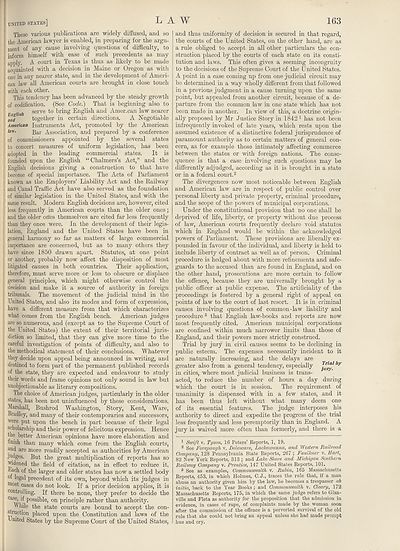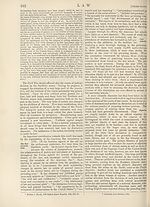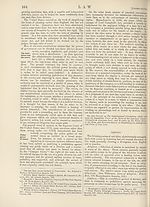New volumes of the Encyclopædia Britannica > Volume 30, K-MOR
(187) Page 163
Download files
Complete book:
Individual page:
Thumbnail gallery: Grid view | List view

UNITED STATES]
These various publications are widely diffused, and so
the American lawyer is enabled, in preparing for the argu¬
ment of any cause involving questions of difficulty, to
inform himself with ease of such precedents as may
apply. A court in Texas is thus as likely to be made
acquainted with a decision in Maine or Oregon as with
one in any nearer state, and in the development of Ameri¬
can law all American courts are brought in close touch
with each other.
This tendency has been advanced by the steady growth
of codification. (See Code.) That is beginning also to
Ea list serve f° bring English and American law nearer
and together in certain directions. A Negotiable
American Instruments Act, promoted by the American
law- Bar Association, and prepared by a conference
of commissioners appointed by the several states
to concert measures of uniform legislation, has been
adopted in the leading commercial states. It is
founded upon the English “ Chalmers’s Act,” and the
English decisions giving a construction to that have
become of special importance. The Acts of Parliament
known as the Employers’ Liability Act and the Railway
and Canal Traffic Act have also served as the foundation
of similar legislation in the United States, and with the
same result. Modern English decisions are, however, cited
less frequently in American courts than the older ones;
and the older ones themselves are cited far less frequently
than they once were. In the development of their legis¬
lation, England and the United States have been in
general harmony so far as matters of large commercial
importance are concerned, but as to many others they
have since 1850 drawn apart. Statutes, at one point
or another, probably now affect the disposition of most
litigated causes in both countries. Their application,
therefore, must serve more or less to obscure or displace
general principles, which might otherwise control the
decision and make it a source of authority in foreign
tribunals. The movement of the judicial mind in the
United States, and also its modes and form of expression,
have a different measure from that which characterizes
what comes from the English bench. American judges
are so numerous, and (except as to the Supreme Court of
the United States) the extent of their territorial juris¬
diction so limited, that they can give more time to the
careful investigation of points of difficulty, and also to
the methodical statement of their conclusions. Whatever
they decide upon appeal being announced in writing, and
destined to form part of the permanent published records
of the state, they are expected and endeavour to study
their words and frame opinions not only sound in law but
unobjectionable as literary compositions.
The choice of American judges, particularly in the older
states, has been not uninfluenced by these considerations.
Marshall, Bushrod Washington, Story, Kent, Ware,
Bradley, and many of their contemporaries and successors,
were put upon the bench in part because of their legal
scholarship and their power of felicitous expression. Hence
the better American opinions have more elaboration and
finish than many which come from the English courts,
and are more readily accepted as authorities by American
judges. But the great multiplication of reports has so
widened the field of citation, as in effect to reduce it.
Each of the larger and older states has now a settled body
of legal precedent of its own, beyond which its judges in
most cases do not look. If a prior decision applies, it is
controlling. If there be none, they prefer to decide the
case,^ if possible, on principle rather than authority.
While the state courts are bound to accept the con¬
struction placed upon the Constitution and laws of the
United States by the Supreme Court of the United States,
163
and thus uniformity of decision is secured in that regard,
the courts of the United States, on the other hand, are as
a rule obliged to accept in all other particulars the con¬
struction placed by the courts of each state on its consti¬
tution and laws. This often gives a seeming incongruity
to the decisions of the Supreme Court of the United States.
A point in a case coming up from one judicial circuit may
be determined in a way wholly different from that followed
in a previous judgment in a cause turning upon the same
point, but appealed from another circuit, because of a de¬
parture from the common law in one state which has not
been made in another. In view of this, a doctrine origin¬
ally proposed by Mr Justice Story in 1842 1 has not been
infrequently invoked of late years, which rests upon the
assumed existence of a distinctive federal jurisprudence of
paramount authority as to certain matters of general con¬
cern, as for example those intimately affecting commerce
between the states or with foreign nations. The conse¬
quence is that a case involving such questions may be
differently adjudged, according as it is brought in a state
or in a federal court.2
The divergences now most noticeable between English
and American law are in respect of public control over
personal liberty and private property, criminal procedure,
and the scope of the powers of municipal corporations.
Under the constitutional provision that no one shall be
deprived of life, liberty, or property without due process
of law, American courts frequently declare void statutes
which in England would be within the acknowledged
powers of Parliament. These provisions are liberally ex¬
pounded in favour of. the individual, and liberty is held to
include liberty of contract as well as of person. Criminal
procedure is hedged about with more refinements and safe¬
guards to the accused than are found in England, and on
the other hand, prosecutions are more certain to follow
the offence, because they are universally brought by a
public officer at public expense. The artificiality of the
proceedings is fostered by a general right of appeal on
points of law to the court of last resort. It is in criminal
causes involving questions of common-law liability and
procedure 3 that English law-books and reports are now
most frequently cited. American municipal corporations
are confined within much narrower limits than those of
England, and their powers more strictly construed.
Trial by jury in civil causes seems to be declining in
public esteem. The expenses necessarily incident to it
are naturally increasing, and the delays are
greater also from a general tendency, especially Jury1 by
in cities, where most judicial business is trans¬
acted, to reduce the number of hours a day during
which the court is in session. The requirement of
unanimity is dispensed with in a few states, and it
has been thus left without what many deem one
of its essential features. The judge interposes his
authority to direct and expedite the progress of the trial
less frequently and less peremptorily than in England. A
jury is waived more often than formerly, and there is a
1 Swift v. Tyson, 16 Peters’ Reports, 1, 19.
2 See Forepauyh v. Delaware, Lackaioanna, and Western Railroad
Company, 128 Pennsylvania State Reports, 267 ; Faulkner v. Hart,
82 New York Reports, 313 ; and Lake Shore and Michigan Southern
Railway Company v. Prentice, 147 United States Reports, 101.
3 See as examples, Commonwealth v. Rubin, 165 Massachusetts
Reports, 453, in which Holmes, C.J., traces the rule that, if a man
abuse an authority given him by the law, he becomes a trespasser ab
initio, back to the Year Books ; and Commonwealth v. Cleary, 172
Massachusetts Reports, 175, in which the same judge refers to Glan-
ville and Fleta as authority for the proposition that the admission in
evidence, in cases of rape, of complaints made by the woman soon
after the commission of the offence is a perverted survival of the old
rule that she could not bring an appeal unless she had made prompt
hue and cry.
LAW
These various publications are widely diffused, and so
the American lawyer is enabled, in preparing for the argu¬
ment of any cause involving questions of difficulty, to
inform himself with ease of such precedents as may
apply. A court in Texas is thus as likely to be made
acquainted with a decision in Maine or Oregon as with
one in any nearer state, and in the development of Ameri¬
can law all American courts are brought in close touch
with each other.
This tendency has been advanced by the steady growth
of codification. (See Code.) That is beginning also to
Ea list serve f° bring English and American law nearer
and together in certain directions. A Negotiable
American Instruments Act, promoted by the American
law- Bar Association, and prepared by a conference
of commissioners appointed by the several states
to concert measures of uniform legislation, has been
adopted in the leading commercial states. It is
founded upon the English “ Chalmers’s Act,” and the
English decisions giving a construction to that have
become of special importance. The Acts of Parliament
known as the Employers’ Liability Act and the Railway
and Canal Traffic Act have also served as the foundation
of similar legislation in the United States, and with the
same result. Modern English decisions are, however, cited
less frequently in American courts than the older ones;
and the older ones themselves are cited far less frequently
than they once were. In the development of their legis¬
lation, England and the United States have been in
general harmony so far as matters of large commercial
importance are concerned, but as to many others they
have since 1850 drawn apart. Statutes, at one point
or another, probably now affect the disposition of most
litigated causes in both countries. Their application,
therefore, must serve more or less to obscure or displace
general principles, which might otherwise control the
decision and make it a source of authority in foreign
tribunals. The movement of the judicial mind in the
United States, and also its modes and form of expression,
have a different measure from that which characterizes
what comes from the English bench. American judges
are so numerous, and (except as to the Supreme Court of
the United States) the extent of their territorial juris¬
diction so limited, that they can give more time to the
careful investigation of points of difficulty, and also to
the methodical statement of their conclusions. Whatever
they decide upon appeal being announced in writing, and
destined to form part of the permanent published records
of the state, they are expected and endeavour to study
their words and frame opinions not only sound in law but
unobjectionable as literary compositions.
The choice of American judges, particularly in the older
states, has been not uninfluenced by these considerations.
Marshall, Bushrod Washington, Story, Kent, Ware,
Bradley, and many of their contemporaries and successors,
were put upon the bench in part because of their legal
scholarship and their power of felicitous expression. Hence
the better American opinions have more elaboration and
finish than many which come from the English courts,
and are more readily accepted as authorities by American
judges. But the great multiplication of reports has so
widened the field of citation, as in effect to reduce it.
Each of the larger and older states has now a settled body
of legal precedent of its own, beyond which its judges in
most cases do not look. If a prior decision applies, it is
controlling. If there be none, they prefer to decide the
case,^ if possible, on principle rather than authority.
While the state courts are bound to accept the con¬
struction placed upon the Constitution and laws of the
United States by the Supreme Court of the United States,
163
and thus uniformity of decision is secured in that regard,
the courts of the United States, on the other hand, are as
a rule obliged to accept in all other particulars the con¬
struction placed by the courts of each state on its consti¬
tution and laws. This often gives a seeming incongruity
to the decisions of the Supreme Court of the United States.
A point in a case coming up from one judicial circuit may
be determined in a way wholly different from that followed
in a previous judgment in a cause turning upon the same
point, but appealed from another circuit, because of a de¬
parture from the common law in one state which has not
been made in another. In view of this, a doctrine origin¬
ally proposed by Mr Justice Story in 1842 1 has not been
infrequently invoked of late years, which rests upon the
assumed existence of a distinctive federal jurisprudence of
paramount authority as to certain matters of general con¬
cern, as for example those intimately affecting commerce
between the states or with foreign nations. The conse¬
quence is that a case involving such questions may be
differently adjudged, according as it is brought in a state
or in a federal court.2
The divergences now most noticeable between English
and American law are in respect of public control over
personal liberty and private property, criminal procedure,
and the scope of the powers of municipal corporations.
Under the constitutional provision that no one shall be
deprived of life, liberty, or property without due process
of law, American courts frequently declare void statutes
which in England would be within the acknowledged
powers of Parliament. These provisions are liberally ex¬
pounded in favour of. the individual, and liberty is held to
include liberty of contract as well as of person. Criminal
procedure is hedged about with more refinements and safe¬
guards to the accused than are found in England, and on
the other hand, prosecutions are more certain to follow
the offence, because they are universally brought by a
public officer at public expense. The artificiality of the
proceedings is fostered by a general right of appeal on
points of law to the court of last resort. It is in criminal
causes involving questions of common-law liability and
procedure 3 that English law-books and reports are now
most frequently cited. American municipal corporations
are confined within much narrower limits than those of
England, and their powers more strictly construed.
Trial by jury in civil causes seems to be declining in
public esteem. The expenses necessarily incident to it
are naturally increasing, and the delays are
greater also from a general tendency, especially Jury1 by
in cities, where most judicial business is trans¬
acted, to reduce the number of hours a day during
which the court is in session. The requirement of
unanimity is dispensed with in a few states, and it
has been thus left without what many deem one
of its essential features. The judge interposes his
authority to direct and expedite the progress of the trial
less frequently and less peremptorily than in England. A
jury is waived more often than formerly, and there is a
1 Swift v. Tyson, 16 Peters’ Reports, 1, 19.
2 See Forepauyh v. Delaware, Lackaioanna, and Western Railroad
Company, 128 Pennsylvania State Reports, 267 ; Faulkner v. Hart,
82 New York Reports, 313 ; and Lake Shore and Michigan Southern
Railway Company v. Prentice, 147 United States Reports, 101.
3 See as examples, Commonwealth v. Rubin, 165 Massachusetts
Reports, 453, in which Holmes, C.J., traces the rule that, if a man
abuse an authority given him by the law, he becomes a trespasser ab
initio, back to the Year Books ; and Commonwealth v. Cleary, 172
Massachusetts Reports, 175, in which the same judge refers to Glan-
ville and Fleta as authority for the proposition that the admission in
evidence, in cases of rape, of complaints made by the woman soon
after the commission of the offence is a perverted survival of the old
rule that she could not bring an appeal unless she had made prompt
hue and cry.
LAW
Set display mode to:
![]() Universal Viewer |
Universal Viewer | ![]() Mirador |
Large image | Transcription
Mirador |
Large image | Transcription
Images and transcriptions on this page, including medium image downloads, may be used under the Creative Commons Attribution 4.0 International Licence unless otherwise stated. ![]()
| Encyclopaedia Britannica > New volumes of the Encyclopædia Britannica > Volume 30, K-MOR > (187) Page 163 |
|---|
| Permanent URL | https://digital.nls.uk/193569932 |
|---|
| Attribution and copyright: |
|
|---|---|
| Shelfmark | EB.18 |
|---|---|
| Description | Ten editions of 'Encyclopaedia Britannica', issued from 1768-1903, in 231 volumes. Originally issued in 100 weekly parts (3 volumes) between 1768 and 1771 by publishers: Colin Macfarquhar and Andrew Bell (Edinburgh); editor: William Smellie: engraver: Andrew Bell. Expanded editions in the 19th century featured more volumes and contributions from leading experts in their fields. Managed and published in Edinburgh up to the 9th edition (25 volumes, from 1875-1889); the 10th edition (1902-1903) re-issued the 9th edition, with 11 supplementary volumes. |
|---|---|
| Additional NLS resources: |
|

